Abstract
A total of 79 infants born at less than 32 weeks' gestation were studied with serial renal ultrasound scans to assess the incidence of nephrocalcinosis. Twenty one infants developed renal calcification giving an overall incidence of 26.6% in the study group. Affected infants were significantly smaller (mean (SD) birth weight 940 (323) g) and significantly less mature (mean (SD) gestation 26.9 (1.9) weeks). In 17 patients the calcification was represented by hyperechogenic renal pyramids alone, and in four patients renal calculi were demonstrated. Factors associated with renal calcification included hypophosphataemia, hypercalcaemia, hypercreatininaemia, and prolonged oxygen requirement during the first month of life. Multivariate analysis showed that the strongest clinical indicator of calcification was duration of oxygen treatment. Infants who still required oxygen treatment at 28 days had a 62% chance of developing renal calcification.
Full text
PDF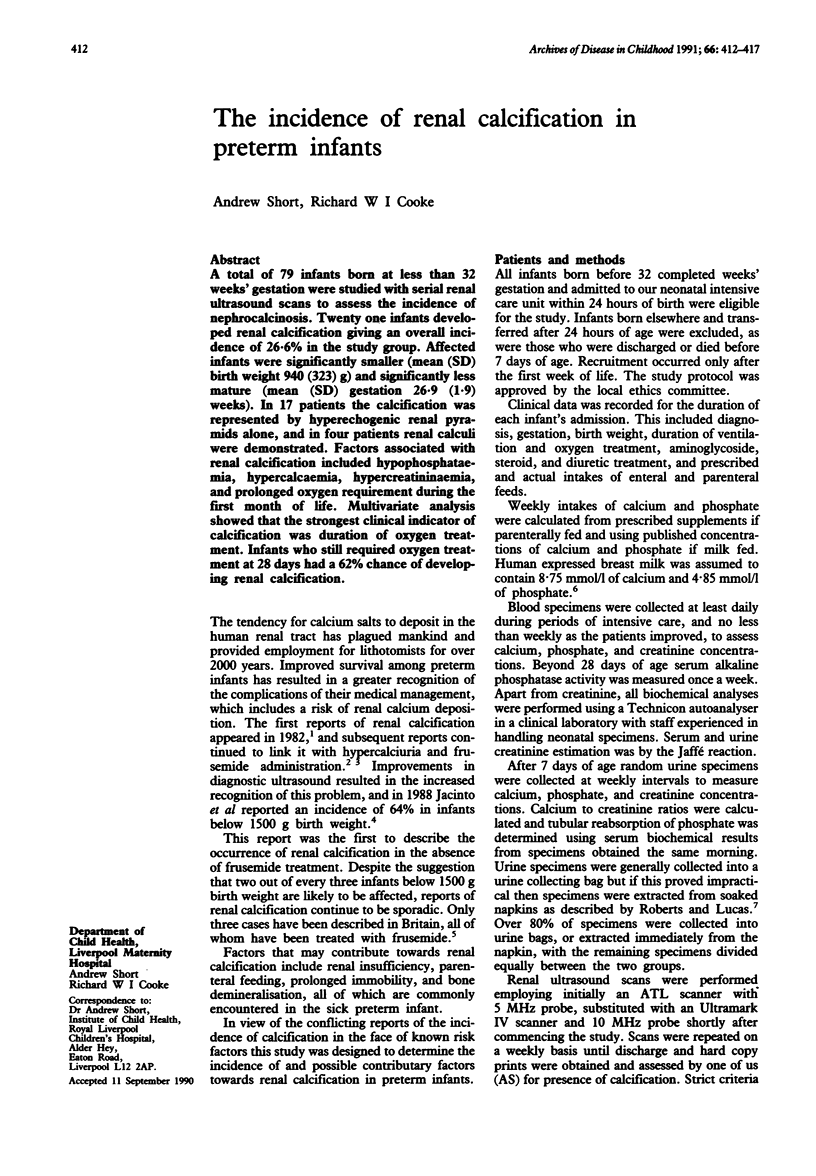
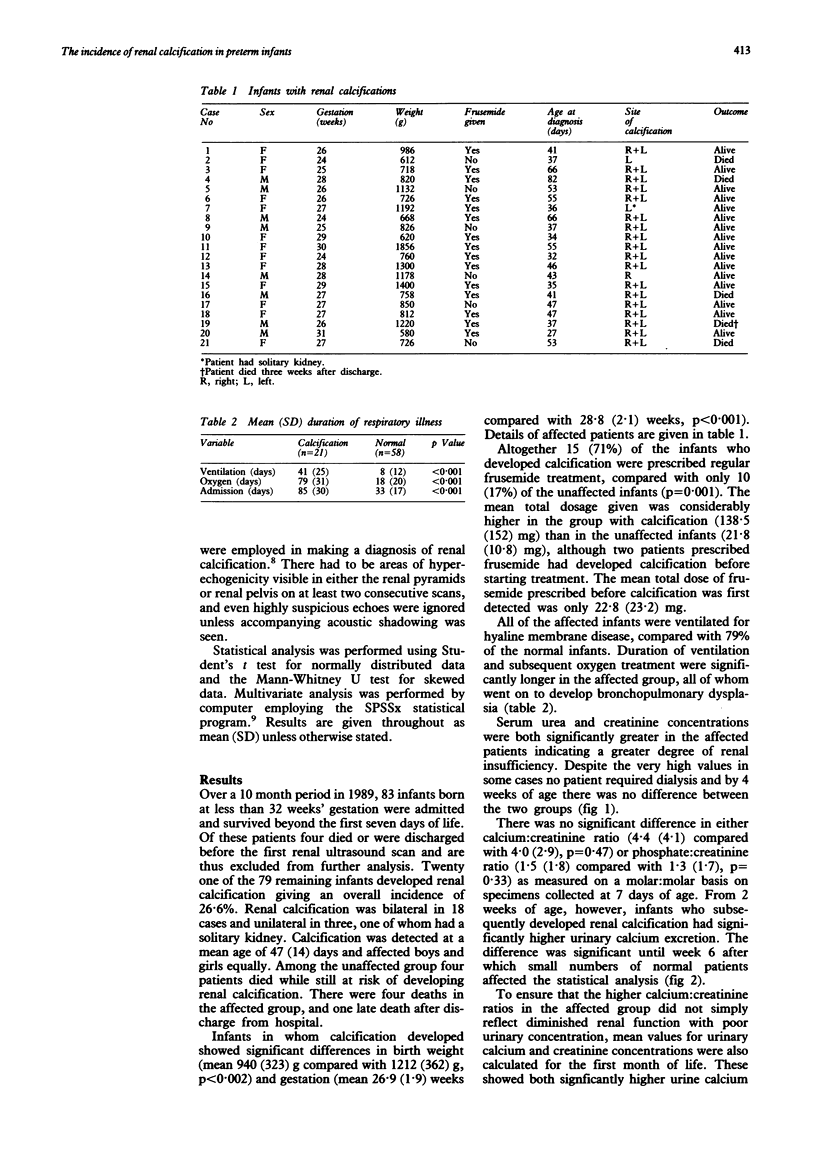
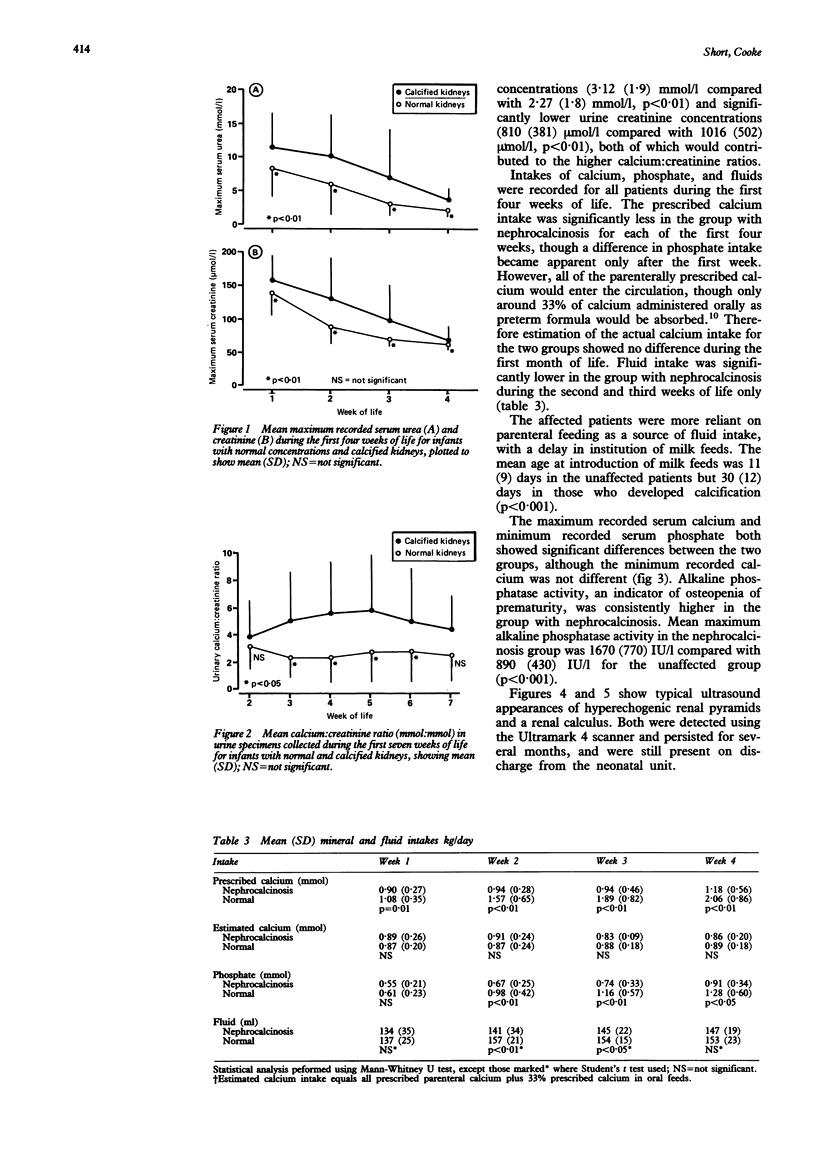
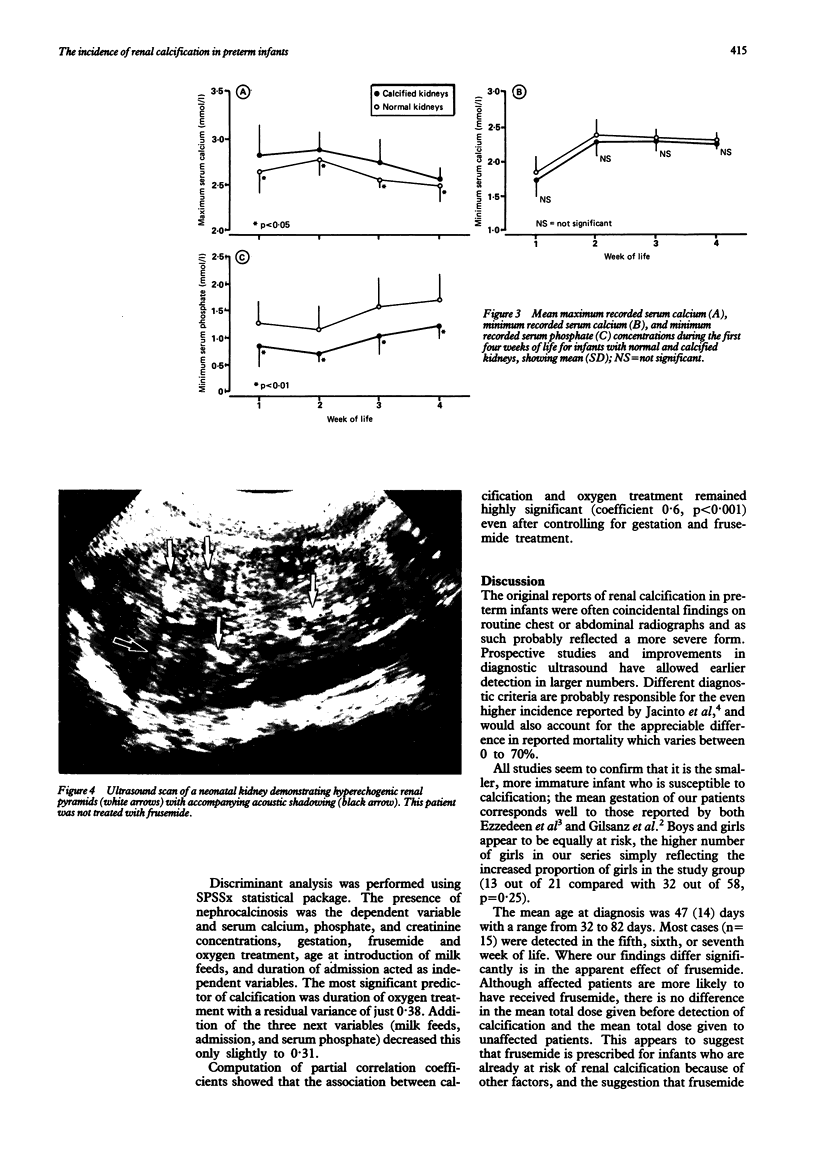
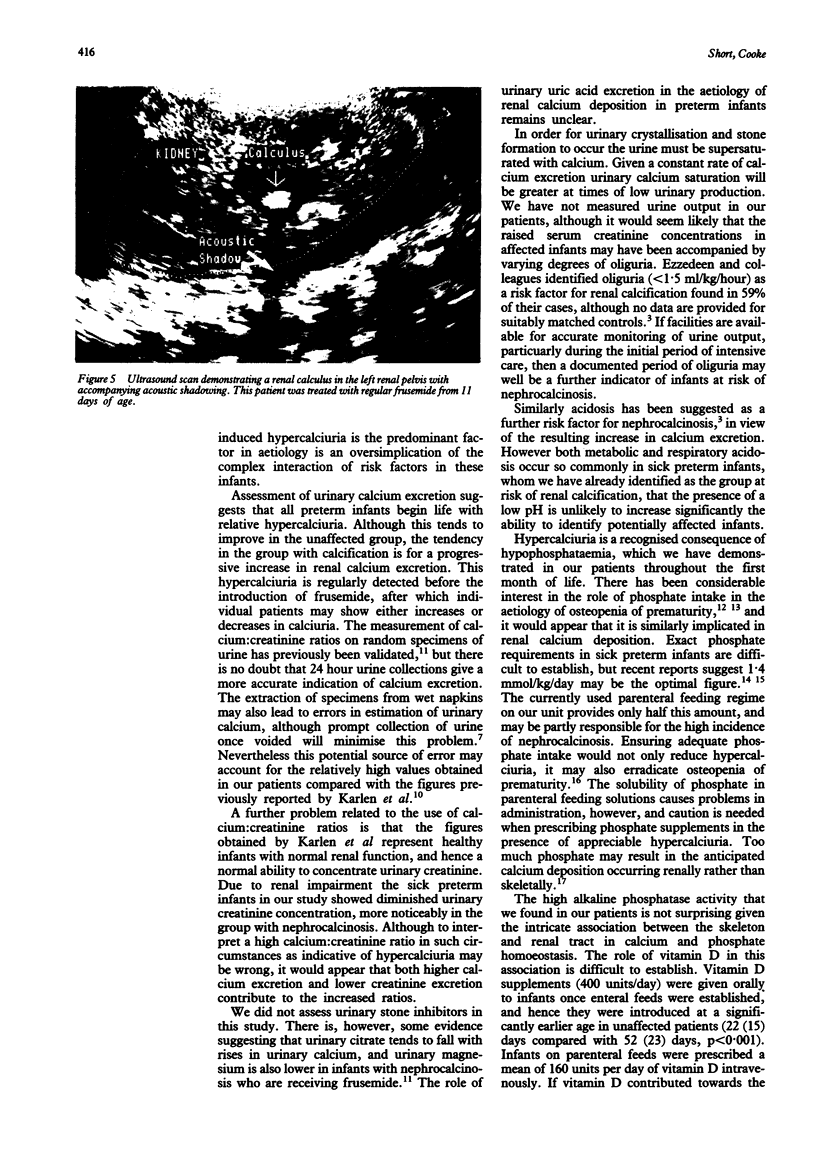
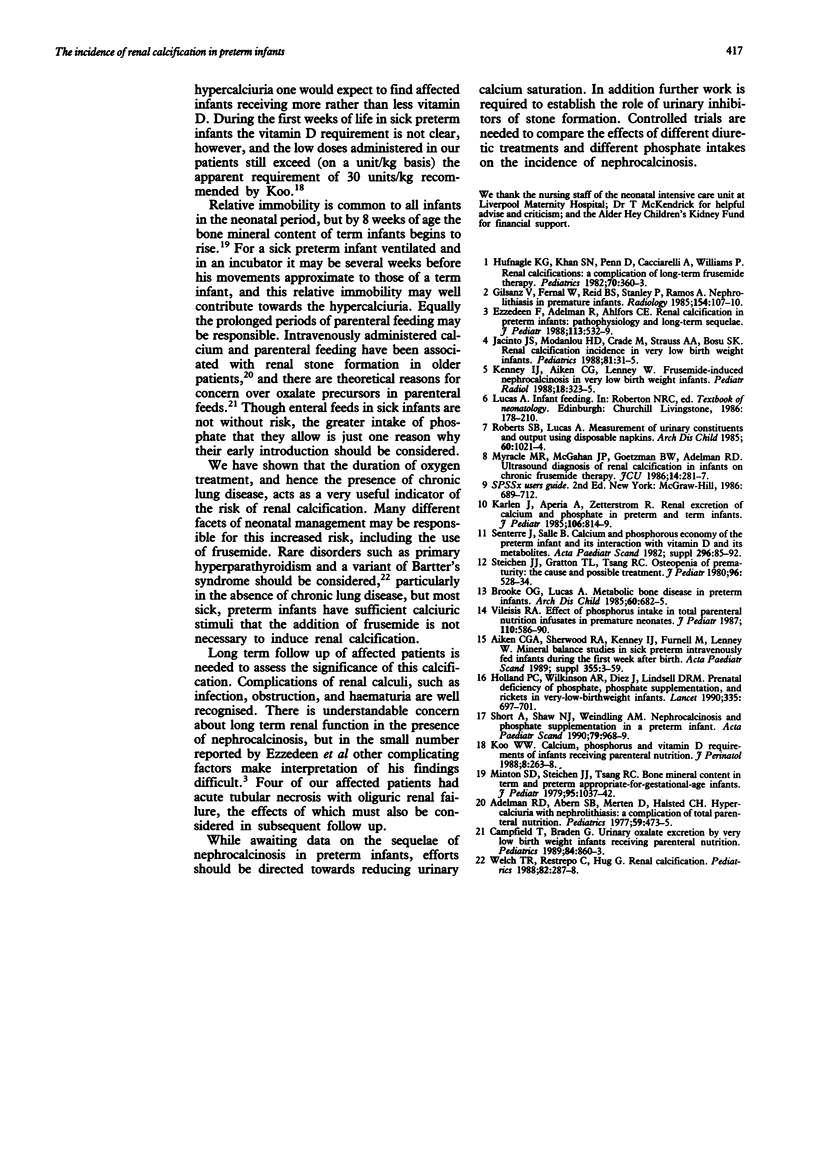
Images in this article
Selected References
These references are in PubMed. This may not be the complete list of references from this article.
- Adelman R. D., Abern S. B., Merten D., Halsted C. H. Hypercalciuria with nephrolithiasis: a complication of total parenteral nutrition. Pediatrics. 1977 Mar;59(3):473–475. [PubMed] [Google Scholar]
- Brooke O. G., Lucas A. Metabolic bone disease in preterm infants. Arch Dis Child. 1985 Jul;60(7):682–685. doi: 10.1136/adc.60.7.682. [DOI] [PMC free article] [PubMed] [Google Scholar]
- Campfield T., Braden G. Urinary oxalate excretion by very low birth weight infants receiving parenteral nutrition. Pediatrics. 1989 Nov;84(5):860–863. [PubMed] [Google Scholar]
- Ezzedeen F., Adelman R. D., Ahlfors C. E. Renal calcification in preterm infants: pathophysiology and long-term sequelae. J Pediatr. 1988 Sep;113(3):532–539. doi: 10.1016/s0022-3476(88)80647-4. [DOI] [PubMed] [Google Scholar]
- Gilsanz V., Fernal W., Reid B. S., Stanley P., Ramos A. Nephrolithiasis in premature infants. Radiology. 1985 Jan;154(1):107–110. doi: 10.1148/radiology.154.1.3964925. [DOI] [PubMed] [Google Scholar]
- Holland P. C., Wilkinson A. R., Diez J., Lindsell D. R. Prenatal deficiency of phosphate, phosphate supplementation, and rickets in very-low-birthweight infants. Lancet. 1990 Mar 24;335(8691):697–701. doi: 10.1016/0140-6736(90)90810-r. [DOI] [PubMed] [Google Scholar]
- Hufnagle K. G., Khan S. N., Penn D., Cacciarelli A., Williams P. Renal calcifications: a complication of long-term furosemide therapy in preterm infants. Pediatrics. 1982 Sep;70(3):360–363. [PubMed] [Google Scholar]
- Jacinto J. S., Modanlou H. D., Crade M., Strauss A. A., Bosu S. K. Renal calcification incidence in very low birth weight infants. Pediatrics. 1988 Jan;81(1):31–35. [PubMed] [Google Scholar]
- Karlén J., Aperia A., Zetterström R. Renal excretion of calcium and phosphate in preterm and term infants. J Pediatr. 1985 May;106(5):814–819. doi: 10.1016/s0022-3476(85)80364-4. [DOI] [PubMed] [Google Scholar]
- Kenney I. J., Aiken C. G., Lenney W. Frusemide-induced nephrocalcinosis in very low birth weight infants. Pediatr Radiol. 1988;18(4):323–325. doi: 10.1007/BF02389002. [DOI] [PubMed] [Google Scholar]
- Koo W. W. Calcium, phosphorus, and vitamin D requirements of infants receiving parenteral nutrition. J Perinatol. 1988 Summer;8(3):263–268. [PubMed] [Google Scholar]
- Minton S. D., Steichen J. J., Tsang R. C. Bone mineral content in term and preterm appropriate-for-gestational-age infants. J Pediatr. 1979 Dec;95(6):1037–1042. doi: 10.1016/s0022-3476(79)80305-4. [DOI] [PubMed] [Google Scholar]
- Myracle M. R., McGahan J. P., Goetzman B. W., Adelman R. D. Ultrasound diagnosis of renal calcification in infants on chronic furosemide therapy. J Clin Ultrasound. 1986 May;14(4):281–287. doi: 10.1002/jcu.1870140408. [DOI] [PubMed] [Google Scholar]
- Roberts S. B., Lucas A. Measurement of urinary constituents and output using disposable napkins. Arch Dis Child. 1985 Nov;60(11):1021–1024. doi: 10.1136/adc.60.11.1021. [DOI] [PMC free article] [PubMed] [Google Scholar]
- Senterre J., Salle B. Calcium and phosphorus economy of the preterm infant and its interaction with vitamin D and its metabolites. Acta Paediatr Scand Suppl. 1982;296:85–92. doi: 10.1111/j.1651-2227.1982.tb09604.x. [DOI] [PubMed] [Google Scholar]
- Steichen J. J., Gratton T. L., Tsang R. C. Osteopenia of prematurity: the cause and possible treatment. J Pediatr. 1980 Mar;96(3 Pt 2):528–534. doi: 10.1016/s0022-3476(80)80861-4. [DOI] [PubMed] [Google Scholar]
- Vileisis R. A. Effect of phosphorus intake in total parenteral nutrition infusates in premature neonates. J Pediatr. 1987 Apr;110(4):586–590. doi: 10.1016/s0022-3476(87)80558-9. [DOI] [PubMed] [Google Scholar]
- Welch T. R., Restrepo de Rovetto C., Hug G. Renal calcification. Pediatrics. 1988 Aug;82(2):287–288. [PubMed] [Google Scholar]




